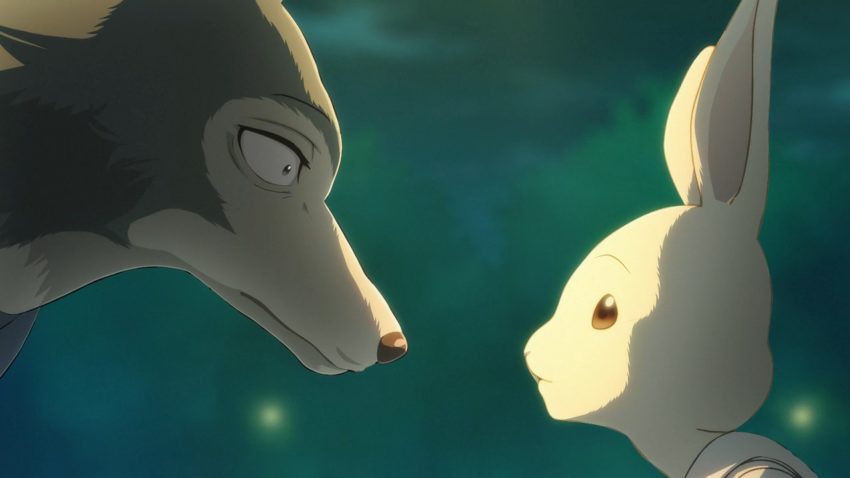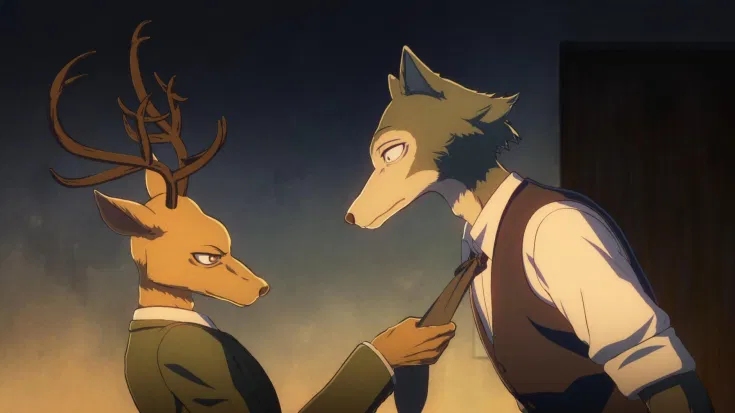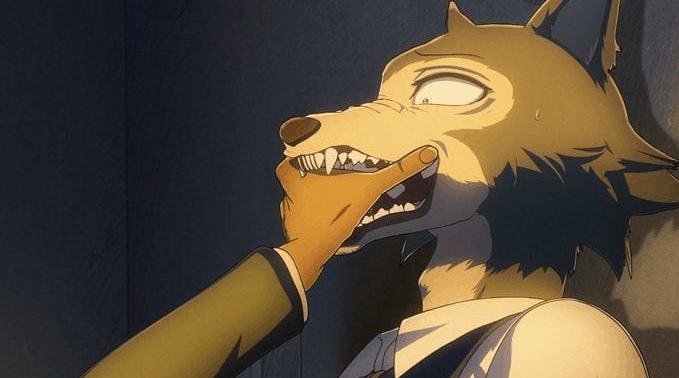Carnivore Culture
May 18, 2021 · 1 comment
By Jeannette Ng.

Beastars is the story of Legoshi, an achingly awkward wolf who struggles with his carnivore side as like many of his fellow classmates, he is no longer a cute puppy and he feels an instinctive pull towards violence, blood and meat. Irrevocably intertwined with that desire for blood is also lust, sex and death, bound up together not just in Leogshi’s confused teenage mind, but also that of his wider society.
There’s a certain temptation to read Beastars as an allegory about race. After all, that was what is going on beneath the surface in Disney’s Zootopia, which has a very similar premise of herbivores and carnivores living alongside one another in a sprawling metropolis. Amid a pastiche of conspiracy thrillers and gangster dramas, Zootopia tries to anchor a parable about racial profiling and drugs scares where the treatment of predators broadly (and very imperfectly) map onto treatment of racial minorities in America.
But Beastars is quite a different creature. Both the anime and its manga original open with the brutal murder of Tem, an alpaca, and follows the shockwaves that this single act of violence sends through the student body of Cherryton Academy.
But under the same catalytic full moon, Legoshi bites Haru, a dwarf rabbit and fellow student. For all that he immediately regrets his action, and would continually interrogate himself over why he did it, even the paradigm of weakness and control is itself suspect – he simply lives in the aftermath of it. Despite an escalating determination to be otherwise, Legoshi is always painfully aware of the violence he is capable of, and that only through conscious choice is he any different from Tem’s murderer.

Though the eating of meat is illegal within the world of Beastars, there exists a dark, violent underside to its society – a fact even alluded to in Satoru Kosaki’s musical score, with track listings like “Cannibalism”, “Devour This” and “Impending Darkness.” The world is not as kind as Legoshi believes it to be. A recurring justification is the ideal that society can only pretend at kindness, that peace exists only because there is a black market as an outlet for carnivores’ inextinguishable lust for meat.
Beastars uses a mix of both real-world biology as well as its own fantastical world-building. In the real world, giant pandas are an immense oddity, having the digestive capability to be omnivorous but eating only bamboo. This bit of animal trivia is folded into the character of Gouhin, a giant panda who acts as a vigilante doctor who forcefully rehabilitates carnivores who have gone meat-mad. Louis, the red deer, serves as a foil for Legoshi – in the real world, stags are known to consume the bones (as well as the meat) of dead animals in order to have enough calcium for their immense horns.

But the eating of meat, whilst undeniably linked to masculinity and power within the Anglophone world, has a very different cultural connection in Japan. With a long history of Buddhism and scarcity, meat-eating has not been a constant in the Japanese diet, which was largely pescatarian for most of human history. The first official decree to ban the consumption of specific animals during farming months was in the 7th century AD, and over time this evolved into a more-or-less blanket taboo with exceptions made for meat (especially game) as medicine.
More relevant to Beastars is how meat entered the Japanese diet after the Meiji Restoration in 1868. In the scramble to modernise and militarise in the face of Western imperialism, a theory arose that the Japanese were physically weaker than Europeans because they didn’t eat meat or drink milk. There followed a flurry of decrees and initiatives – the Emperor was prevailed upon to eat meat in public; sickly soldiers recuperating from Japan’s foreign wars were urged to literally beef themselves up, and the open plains of Hokkaido were turned into cattle-farms and dairies. Needless to say, meat is now very much part of the modern Japanese diet.
Each instance of meat-eating by the characters in Beastars has an almost mystical air. There is a potential for powerful quasi-medicinal effects as Bill the tiger uses rabbit blood to “dope” himself up and become stronger, more confident and violent. Legoshi’s consumption of a caterpillar also acts as medicine, and the ensuing imagined conversation with the moth that will never exist because of him has a philosophically Buddhist aura.

Legoshi’s struggles with his own violent, even lustful, urges for meat read as a struggle with his own masculinity. Central to the story is his relationship with Haru, the dwarf rabbit. His desire to eat her has sublimated into an obsessive, protective love and her attraction to him is bound up with her own depressive death wish. Their emotional baggage interlocks like puzzle pieces into a compelling relationship that struggles towards any semblance of balance.
This is not to say that Beastars is a simple and misguided allegory where carnivores are just “men”. It is just that the show’s carnivore characters skew male and that each has an inescapable and uncomfortable relationship with violence — especially sexual violence.
Tooth and claw aren’t the only paths to power in the world of Beastars, nor are they the only weapons. Louis the red deer pulls a gun on Bill the tiger in an early confrontation between the two characters. Louis is consistently struggling with his need to project power and strength, despite what he perceives to be his own physical frailties. He cannot allow himself to appear vulnerable. The need to consistently perform his masculinity is something that ultimately and repeatedly hurts Louis. Like stags in the real world, Louis sheds his horns annually but instead of simply going without them, he wears prosthetics to compensate. Later, he starves himself in order to eat meat alongside his gang of lions.
The eating of meat in Beastars is violent and unclean, even carnal. That relationship with sex is repeatedly made explicit, the act of consumption and predation is likened to the uncomfortable vulnerability and even intimacy of sex. The manga includes interludes from female herbivores whose experiences with predation parallel human sexual harassment and assault. From the self-destructive gazelle who works as a stripper in the black market to the sheep office lady who remains consistently overlooked at work, each portrait deepens the ways in which the confidence and power of carnivores, as well as their obliviousness to the privilege that comes with that, parallels the dark and toxic sides of masculinity in our world.
Jeannette Ng is the author of Under the Pendulum Sun. Beastars is streaming on Netflix. The soundtrack album is released in the UK by Anime Limited.
Phoenix
May 19, 2021 11:03 pm
Must of been a late night with a few drink when writing this article I suppose.